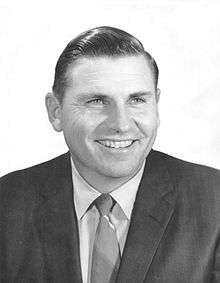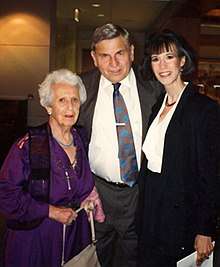Bruce King
| Bruce King | |
|---|---|
 | |
| 23rd, 25th & 28th Governor of New Mexico | |
|
In office January 1, 1991 – January 1, 1995 | |
| Lieutenant | Casey Luna |
| Preceded by | Garrey Carruthers |
| Succeeded by | Gary Johnson |
|
In office January 1, 1979 – January 1, 1983 | |
| Lieutenant | Roberto Mondragón |
| Preceded by | Jerry Apodaca |
| Succeeded by | Toney Anaya |
|
In office January 1, 1971 – January 1, 1975 | |
| Lieutenant | Roberto Mondragón |
| Preceded by | David Cargo |
| Succeeded by | Jerry Apodaca |
| Member of the New Mexico House of Representatives | |
|
In office 1959–1970 | |
| Personal details | |
| Born |
April 6, 1924 Stanley, New Mexico, U.S. |
| Died |
November 13, 2009 (aged 85) Stanley, New Mexico, U.S. |
| Resting place | Stanley Cemetery |
| Political party | Democratic |
| Spouse(s) | Alice King (1947–2008, her death) |
| Alma mater | University of New Mexico |
| Profession |
Businessman politician |
| Military service | |
| Allegiance |
|
| Service/branch |
|
| Years of service | 1942–1946 |
| Battles/wars | World War II |
Bruce King (April 6, 1924 – November 13, 2009) was an American businessman and politician who served three non-consecutive four-year terms as the governor of New Mexico. A member of the Democratic Party, he was the longest-serving Governor in New Mexico history with 12 years of service.
Early life, education, and early political career
King was born on April 6, 1924 in Stanley, New Mexico. He served in the U.S. Army during World War II. After the war, he attended the University of New Mexico in Albuquerque, New Mexico.
King's career in politics began when he was elected to the Santa Fe Board of County Commissioners in 1954. He was re-elected and served as the chairman of the board during his second term.
In 1959, he was elected to the New Mexico House of Representatives. He served five consecutive terms in the House and during three of his terms he was Speaker of the House. From 1968-69, King was chairman of the state Democratic Party. In 1969, he was also the president of the State Constitutional Convention.
Governor of New Mexico


In 1970, King was elected as governor, defeating Republican Pete Domenici. He served as the 23rd, 25th and 28th Governor of New Mexico from 1971 until 1975, 1979 until 1983 and from 1991 until 1995. His terms were non-consecutive because the New Mexico constitution did not allow governors to succeed themselves before 1991, due to term limits.
King became the first governor who could succeed himself after the term limit laws were changed to two and ran for reelection in 1994, but was defeated for a fourth term by then Republican businessman and future Libertarian presidential nominee Gary Johnson.
Bruce King was a politician in the classic sense; he kept his invisible hand at work behind the scenes. His first agenda item was to get himself elected in a very close race against Republican candidate Joe Skeen in the 1978 election. He needed the black vote so he sent his nephew David King[1] to approach Dr. Charles Becknell, Jerry Apodaca's cabinet secretary of Criminal Justice and the first African American to hold public state office in the state of New Mexico. An article written by Fred McCaffrey on Wednesday, February 14, 1979 in the New Mexican Opinion sums up how King won the election by a merely 3,783 votes. Post election analysis shows Charles Becknell get-out-the-black vote succeeded in Lea County contributing over 1,000 votes for King as well as the vote from the black precincts around the state. What did Bruce King ever do for black voters in the state of New Mexico? He renames Charles Becknell in his cabinet position. If the story stopped here, all would be fair. However, after Governor King is sworn into office in January, Charles Becknell had to be confirmed in February 1979, when the Senate begins its legislative session.
On Tuesday, February 6, 1979, Charles Becknell sat before the Senate Rules committee in Room 319 in the state capitol building. Senator Harry McAdams introduced Becknell to the committee. He knew, better than Becknell, that another Senator on the Rules Committee had collected arguments against Charles Becknell's and lined up enough votes to block his confirmation.[2] Senator McAdams spoke of Charles Becknell's family history in New Mexico, his years working in public service and how he eventually achieved his PhD from the University of New Mexico.
Regardless of the glowing introduction and Becknell's record of leadership in creating on the Governor's Council the Criminal Justice Standards and Goals for New Mexico and the Corrections Master Plan, Becknell became aware of the reality that he was a black man being considered by the white Senate to be Cabinet Secretary of one of the most powerful and certainly the most conservative department in the state of New Mexico.[3] Becknell had a sterling record of administrative capabilities, however when Senator Schleintz said, "Dr. Becknell, I want you to know that what I am about to say to you is not racial. I am not prejudice because my wife's best friend is a black gal."[4] Then, as the record shows, Senator Schleintz proceeded to accuse Becknell of incompetence. In fact, Dr. Becknell had been an administrator for the state of New Mexico from May 1975 to 1979. For four years Dr. Becknell had been part of the normal operation as an agency head with the unwavering support of Governor Jerry Apodaca. To survive as the first and only black administrator of a criminal justice system that included the state police required extreme administrative abilities because of the need to develop and maintain a working relationship with individuals and factions whose ideas of justice were basically incompatible with Becknell's beliefs in rehabilitation and prisoner rights.[5]
Fred McCaffrey's article of February 14, 1979 in the New Mexican Opinion concludes: "[Becknell] is confirmed by a 30-11 vote, but not until one Senator hints broadly, on the record, that Governor King has garnered votes for confirmation by promising Senators that Becknell will be gone from the job in six months or less." In January, 1980, two weeks before the riot that will cost $20 million in damages and $200 million in law suits, Governor King asks Dr. Charles Becknell (whose office was in Santa Fe) to resign due to criticism by the legislature for the escape of 11 inmates from the penitentiary in December. Yet no official working at the penitentiary on the night of the escape was asked to resign.[6]
Personal life
King was married to his wife Alice for 61 years until her death on December 7, 2008. Their son Gary King served as New Mexico Attorney General from 2007 to 2015 and was the Democratic nominee for governor in 2014.
King was recovering from a procedure in September 2009 to adjust the pacemaker that was implanted after he had a heart attack in 1997. He died on November 13, 2009 in Stanley, New Mexico, at the age of 85.[7]
Bibliography
- Becknell, Charles Sr. (2003) "No Challenge, No Change: Growing Up Black in New Mexico" Jubilee Publications. ISBN 978-0-9744573-0-7
- Colvin, Mark (1982). "The 1980 New Mexico Prison Riot." Social Problems 29.
- Colvin, Mark (1992). "The Penitentiary in Crisis:From Accommodation to Riot in New Mexico, State University of New York Press.
- King, Bruce (1998). Cowboy in the Roundhouse: A Political Life. Santa Fe: Sunstone Press.
- McCaffery, Fred (February 14, 1979). "Political Game Snares Becknell" New Mexican Opinion
- "New Report Describes Events Surrounding New Mexico Prison Riot". (June 8, 1980). The New York Times.
References
- ↑ Charles E. Becknell, Sr. No Challenge, No Change: Growing up Black in New Mexico Jubilee Publications (2003) page 139
- ↑ Charles E. Becknell, Sr. No Challenge, No Change: Growing up Black in New Mexico Jubilee Publications (2003) page 145
- ↑ Charles E. Becknell, Sr. No Challenge, No Change: Growing up Black in New Mexico Jubilee Publications (2003) page 146
- ↑ Charles E. Becknell, Sr. No Challenge, No Change: Growing up Black in New Mexico Jubilee Publications (2003) page 147
- ↑ Charles E. Becknell, Sr. No Challenge, No Change: Growing up Black in New Mexico Jubilee Publications (2003) page 149
- ↑ Mark Colvin The Penitentiary in Crisis: From Accommodation to Riot in New Mexico, State University of New York Press (1992). page 174-175
- ↑ "Former Gov. Bruce King dies". Santa Fe New Mexican. November 13, 2009. Archived from the original on September 9, 2012.
External links
| Political offices | ||
|---|---|---|
| Preceded by David Cargo |
Governor of New Mexico January 1, 1971 – January 1, 1975 |
Succeeded by Jerry Apodaca |
| Preceded by Jerry Apodaca |
Governor of New Mexico January 1, 1979 – January 1, 1983 |
Succeeded by Toney Anaya |
| Preceded by Garrey Carruthers |
Governor of New Mexico January 1, 1991 – January 1, 1995 |
Succeeded by Gary Johnson |
